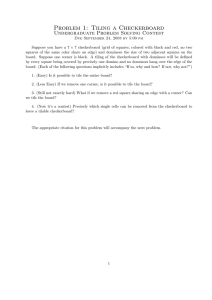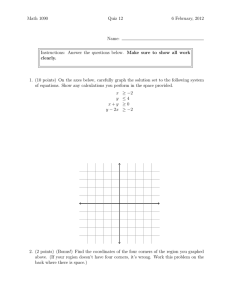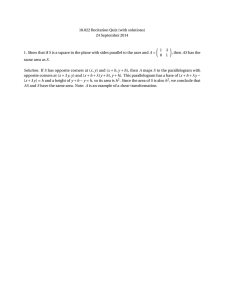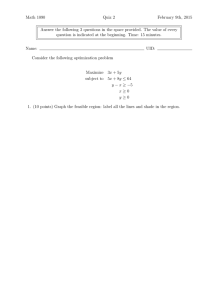Robust Checkerboard Recognition for Efficient Nonplanar Geometry Registration in Projector-camera Systems
advertisement
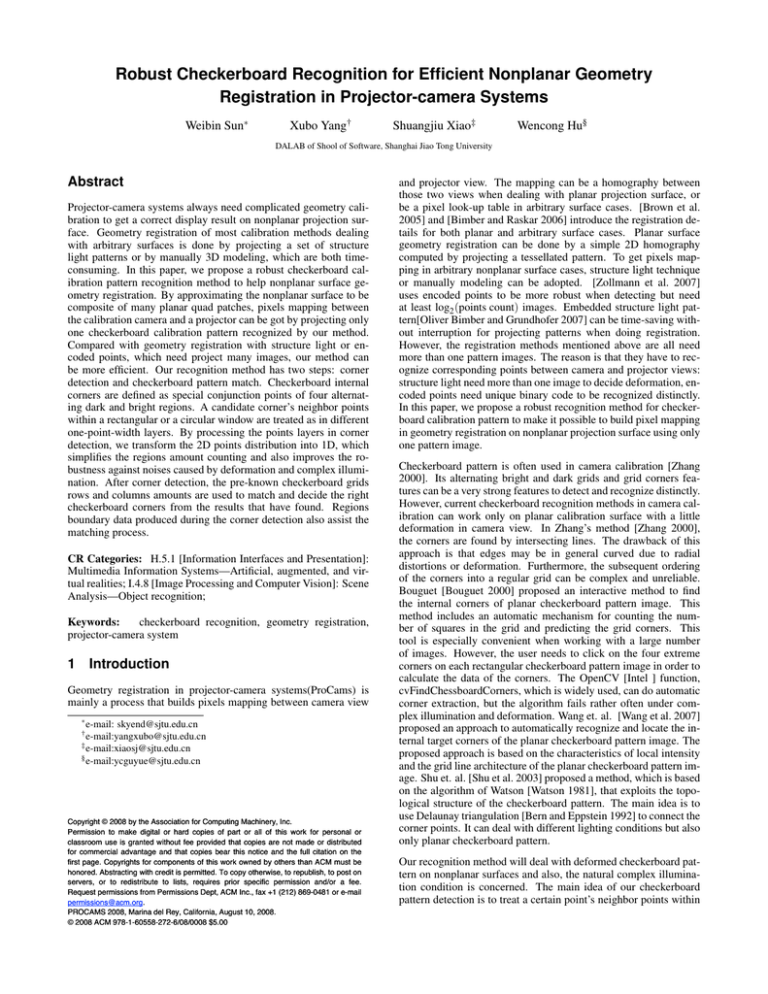
Robust Checkerboard Recognition for Efficient Nonplanar Geometry
Registration in Projector-camera Systems
Weibin Sun∗
Xubo Yang†
Shuangjiu Xiao‡
Wencong Hu§
DALAB of Shool of Software, Shanghai Jiao Tong University
Abstract
Projector-camera systems always need complicated geometry calibration to get a correct display result on nonplanar projection surface. Geometry registration of most calibration methods dealing
with arbitrary surfaces is done by projecting a set of structure
light patterns or by manually 3D modeling, which are both timeconsuming. In this paper, we propose a robust checkerboard calibration pattern recognition method to help nonplanar surface geometry registration. By approximating the nonplanar surface to be
composite of many planar quad patches, pixels mapping between
the calibration camera and a projector can be got by projecting only
one checkerboard calibration pattern recognized by our method.
Compared with geometry registration with structure light or encoded points, which need project many images, our method can
be more efficient. Our recognition method has two steps: corner
detection and checkerboard pattern match. Checkerboard internal
corners are defined as special conjunction points of four alternating dark and bright regions. A candidate corner’s neighbor points
within a rectangular or a circular window are treated as in different
one-point-width layers. By processing the points layers in corner
detection, we transform the 2D points distribution into 1D, which
simplifies the regions amount counting and also improves the robustness against noises caused by deformation and complex illumination. After corner detection, the pre-known checkerboard grids
rows and columns amounts are used to match and decide the right
checkerboard corners from the results that have found. Regions
boundary data produced during the corner detection also assist the
matching process.
CR Categories: H.5.1 [Information Interfaces and Presentation]:
Multimedia Information Systems—Artificial, augmented, and virtual realities; I.4.8 [Image Processing and Computer Vision]: Scene
Analysis—Object recognition;
Keywords:
checkerboard recognition, geometry registration,
projector-camera system
1
Introduction
Geometry registration in projector-camera systems(ProCams) is
mainly a process that builds pixels mapping between camera view
∗ e-mail:
skyend@sjtu.edu.cn
† e-mail:yangxubo@sjtu.edu.cn
‡ e-mail:xiaosj@sjtu.edu.cn
§ e-mail:ycguyue@sjtu.edu.cn
Copyright © 2008 by the Association for Computing Machinery, Inc.
Permission to make digital or hard copies of part or all of this work for personal or
classroom use is granted without fee provided that copies are not made or distributed
for commercial advantage and that copies bear this notice and the full citation on the
first page. Copyrights for components of this work owned by others than ACM must be
honored. Abstracting with credit is permitted. To copy otherwise, to republish, to post on
servers, or to redistribute to lists, requires prior specific permission and/or a fee.
Request permissions from Permissions Dept, ACM Inc., fax +1 (212) 869-0481 or e-mail
permissions@acm.org.
PROCAMS 2008, Marina del Rey, California, August 10, 2008.
© 2008 ACM 978-1-60558-272-6/08/0008 $5.00
and projector view. The mapping can be a homography between
those two views when dealing with planar projection surface, or
be a pixel look-up table in arbitrary surface cases. [Brown et al.
2005] and [Bimber and Raskar 2006] introduce the registration details for both planar and arbitrary surface cases. Planar surface
geometry registration can be done by a simple 2D homography
computed by projecting a tessellated pattern. To get pixels mapping in arbitrary nonplanar surface cases, structure light technique
or manually modeling can be adopted. [Zollmann et al. 2007]
uses encoded points to be more robust when detecting but need
at least log2 (points count) images. Embedded structure light pattern[Oliver Bimber and Grundhofer 2007] can be time-saving without interruption for projecting patterns when doing registration.
However, the registration methods mentioned above are all need
more than one pattern images. The reason is that they have to recognize corresponding points between camera and projector views:
structure light need more than one image to decide deformation, encoded points need unique binary code to be recognized distinctly.
In this paper, we propose a robust recognition method for checkerboard calibration pattern to make it possible to build pixel mapping
in geometry registration on nonplanar projection surface using only
one pattern image.
Checkerboard pattern is often used in camera calibration [Zhang
2000]. Its alternating bright and dark grids and grid corners features can be a very strong features to detect and recognize distinctly.
However, current checkerboard recognition methods in camera calibration can work only on planar calibration surface with a little
deformation in camera view. In Zhang’s method [Zhang 2000],
the corners are found by intersecting lines. The drawback of this
approach is that edges may be in general curved due to radial
distortions or deformation. Furthermore, the subsequent ordering
of the corners into a regular grid can be complex and unreliable.
Bouguet [Bouguet 2000] proposed an interactive method to find
the internal corners of planar checkerboard pattern image. This
method includes an automatic mechanism for counting the number of squares in the grid and predicting the grid corners. This
tool is especially convenient when working with a large number
of images. However, the user needs to click on the four extreme
corners on each rectangular checkerboard pattern image in order to
calculate the data of the corners. The OpenCV [Intel ] function,
cvFindChessboardCorners, which is widely used, can do automatic
corner extraction, but the algorithm fails rather often under complex illumination and deformation. Wang et. al. [Wang et al. 2007]
proposed an approach to automatically recognize and locate the internal target corners of the planar checkerboard pattern image. The
proposed approach is based on the characteristics of local intensity
and the grid line architecture of the planar checkerboard pattern image. Shu et. al. [Shu et al. 2003] proposed a method, which is based
on the algorithm of Watson [Watson 1981], that exploits the topological structure of the checkerboard pattern. The main idea is to
use Delaunay triangulation [Bern and Eppstein 1992] to connect the
corner points. It can deal with different lighting conditions but also
only planar checkerboard pattern.
Our recognition method will deal with deformed checkerboard pattern on nonplanar surfaces and also, the natural complex illumination condition is concerned. The main idea of our checkerboard
pattern detection is to treat a certain point’s neighbor points within
a rectangular or a circular window as in different one-point-width
layers and transform the 2D points distribution into 1D to detect regions. Corners are correlated and clustered by the region boundary
data to recognize the checkerboard corners.
2
Notations and Motivation
(a) Region corner
Let I be the image containing the checkerboard pattern.
I = {~p},
~p = [x, y] denotes the point in I.
(1)
For a vector point ~p, we use (x~p , y~p ) to represent its Cartesian coordinates, (ρ~p , θ~p ) to represent its polar coordinates. In a grayscale
image, we make I(~p) or I(x~p , y~p ) be the intensity of point ~p, IB (~p)
or IB (x~p , y~p ) be the intensity of point ~p in a binary image.
(b) Layers
Figure 1: A region corner and its layers within a window R(~p, 4),
from L1 (~p) to L4 (~p), points are labeled with their layer indices.
A checkerboard internal corner, which we call it the region corner(Fig. 1(a)), has four alternating dark and bright regions around
it. We define a rectangular and a circular window covering the four
regions feature surrounding a candidate corner ~p to be R(~p, w) and
C(~p, w) in eq. 2.
R(~p, w) =
{~pi | |x~pi − x~p | ≤ w, |y~pi − y~p | ≤ w}
C(~p, w) =
{~pi | k~pi −~pk ≤ w}
(a) 1D layers image
w here is always an non-negative integer limit the window’s scope.
R(~p, w) is a set of points that are in a rectangular, actually a 2w + 1
points width square window(we still call it rectangular to be more
general in the rest of this paper). C(~p, w) is a set containing the
points around ~p within a circular window whose radius is w points
and the center is ~p. The circular window can be generated by a Bresenham [Bresenham 1977] circle when implementing to be efficient
and accurate.
The four alternating dark and bright regions around a corner can
be deformed seriously on arbitrary surface. The isotropy against
deformation can be achieved if points within a window are iterated
by circumambulating the corner from the outer to the inner. The
layer is defined in eq. 3 to represent the points being checked in
each circumambulating iteration.
Lr (~p) =< ~p1 , . . . ,~pi , . . . ,~pnr >, i ∈ [1, nr ]
for circular window ~pi ∈ C(p, r) − C(p, r − 1)
for rectangular window ~pi ∈ R(p, r) − R(p, r − 1)
θ~p j < θ~p j+1 , j ∈ [1, nr − 1]
image signal(Fig. 2). It transforms the 2D point distribution within
a window to 1D, then regions in a layer will be line segments after
binarization. That will simplify the detection of regions around a
corner when corners are detected by recognizing the four alternating regions feature in our method.
To be used by the ring-morphology defined in Section 3.1, we define some operators for set operations:
Set cardinality:
Translation:
Complementary set:
3
(4)
For circular window layers Lr (~p) in C(p, w), the Bresenham circle
algorithm will decide the nr . To be used later, we define the first
order derivative in a layer Lr (~p) to be:
IL0 (~pi ) = I(~pi+1 ) − I(~pi )
Figure 2: 1D form of layers from L1 (~p) to L3 (~p) in Fig. 1(b).
|A|
(A) p = {c | c = a + p, a ∈ A}
Ac = {w | w ∈
/ A}
(6)
Detection
(3)
In a window R(p, w) or C(p, w), there are w layers from L1 (~p) to
Lw (~p). nr is the points amount in Lr (~p). For a Lr (~p) in R(p, w),
nr can be calculated by eq. 4.
nr = 4(2r + 1) − 4 = 8r
(b) 1D layers brightness values
(2)
(5)
Note that the coordinate index in Lr should be i in ~pi , this would
make the coordinates in Lr be 1D. A layer is an ordered tuple of
points which are sorted by the sequence in which points are iterated
when circumambulating the corner. The circumambulating can be
performed in the order that the polar coordinates θ~p ’s incremental
direction(note that within each window, we set the polar coordinates origin (0, 0) be the center of the window). Fig. 1(b) shows
the layers in a rectangular window around a corner. A layer Lr (~p)
is actually a nr points long 1D sequential array representing a 1D
Checkerboard pattern detection has two steps, corner detection and
checkerboard match. The first step finds all candidate checkerboard
corners in the image. The second step eliminates noise points and
connects all candidate corners with the help of regions boundaries
data to match the checkerboard pattern. The connected corners set,
which has the same region corners amount to the checkerboard pattern, will be the checkerboard corners.
3.1
Corner Detection
Region corners are detected by checking whether there are four alternating dark and bright regions around a candidate corner within
a window scope. To be efficient and robust, firstly, the image I is resized to a range [ISmin , ISmax )] without changing the
width and height ratio. According to the common camera resolutions from 320 × 240 to 2048 × 1536, the range is set to be
[(300, 200), (2100, 1600)]. There is no difference between the rectangular window and the circular one to achieve isotropy against
deformations when circumambulating the points in layers around
the candidate corner. We will use the rectangular one in rest of this
paper.
The window size parameter, w in R(~p, w) is decided by the checkerboard grid size. To detect the four alternating dark and bright regions, the window should not cover more than four regions, which
are actually four grids surrounding a corner. So window width
2w + 1 should be less than two times of the grid width(we only
consider checkerboard with square grid) gwidth . To be efficient, we
decide the two windows of two neighbor corners belonging to a
same grid should not intersect too much. So 2w + 1 < gwidth and
w ≈ gwidth /2. We also define a a window size range [W Smin ,W Smax ]
to limit the window size for extreme large or small grid. gwidth
can be calculated by the amount of checkerboard grids rows gr and
columns gc and the image size widthI and heightI according to eq. 7
to be a probable value.
gwidth = min{
widthI heightI
,
}
gc
gr
Figure 3: A fake region caused by a line
(7)
Here gr and gc should be known before recognition. eq. 8 shows
the calculating of the window size parameter w.
w=
w0 0
, w is calculated by eq. 9.
2
W Smin
g
w =
Wwidth
Smax
0
(8)
Figure 4: Broken region in L3 (~p) of the region corner in Fig. 1
SEcd is defined to be:
if gwidth < W Smin
if gwidth ∈ [W Smin ,W Smax ]
if gwidth > W Smax
SEcd = {1, . . . , lse }
(9)
The window size parameter does not need high precision, we just
ignore the 1 in 2w + 1 window width in eq. 8. The window size
range [W Smin ,W Smax ] reflects the minimum scope in which a region corner can be identified. The region borders around a corner
may be smoothed or extended to blocks rather than border lines to
lose sharpness because of noise, low camera capturing quality and
complex lighting. To get robustness, the window should be able
to cover all four regions to detect them. However, too large window size will cause low performance. We set this range be [11, 21]
to tolerate the low quality corners in most common camera cases.
The [W Smin ,W Smax ] with value of [11, 21] limits the window widths
from 11 to 21 of R(~p, w). This range may be changed when implementing, however, a points block with over 21 points long width
should not be recognized to be a border line even in human’s eyes,
so for most applications, the range can be fixed to our values without manual change.
A checkerboard corner should have four regions, so κ should be
less than 41 . To be robust, we decide to tolerate the deformed region covering about 18 layer. To produce more redundant corners
to avoid missing corners, we tolerate the minimum region taking
1
1
up only 10
layer. So we set κ to 10
. To avoid incorrect noise reduction, layers with small width parameter r < 2 will not do this
operation. What’s more, because the last point and the first point
of a layer in 1D form are actually continuous in 2D form, a region
may break here because of the 2D to 1D transformation. An example is shown in Fig. 4. These broken regions may be treated as
fake regions when noise reducing because of their short widths. To
avoid this problem, we modify the binary morphology operations
by elongating the layer to repeat it one more time behind its last
point to be cycle-compatible, these modified operations are called
the ring-morphology as in eq. 13.
Dilation:
For each layer, a mean value of the layer points is calculated to do
thresholding as in eq. 10. Let LBr (~p) be the binarization result of
Lr (~p).
A ⊕ring B = { x mod |A| |
(B)x ∩ (A ∪ (A)|A| ) 6= 0}
/
Erosion:
A ring B = { x mod |A| |
(B)x ∩ (A ∪ (A)|A| )c 6= 0}
/
LBr (~p) = {~p0 i | ~p0 i = ~pi , ∀~pi ∈ Lr (~p) and
pi )
∑
0 if I(~pi ) < t
r (~p) I(~
}
IB (~p0 i ) =
,t = ~pi ∈L
|Lr (~p)|
1 if I(~pi ) ≥ t
Opening:
Closing:
A ◦ring B = (A ring B) ⊕ring B
A •ring B = (A ⊕ring B) ring B
(10)
This layer-scope threshold can reduce the negative effects caused
by noises to achieve a locally adaptive thresholding result. After
thresholding, a noise reduction is performed on the binary 1D image signal to remove fake regions, which are mainly caused by lines
or blob points. Fig. 3 shows an example of this fake region caused
by a line. These fake regions are actually regions with very short
widths. We do the binary morphology [Haralick et al. 1987] operations, opening and closing, both of which are with a same 1D
structure elements(SE) SEcd , to remove noises. The SEcd ’s length
is determined by the layer LBr (~p)’s length nr . A proportion κ of the
SEcd length lse and the layer LBr (~p)’s length nr is used to calculate
lse (eq. 11).
lse = nr · κ
(11)
(12)
(13)
The ring-morphology treats a 1D image as a ring that the head and
the end are joined. By performing ring-morphology opening and
closing on the binary layers LBr (~p) after thresholding, we can reduce the fake regions. Then regions count can be calculated by
summing absolute value of the first order derivatives IL0 (~pi ) of this
binary(only 0 and 1 values) layer. To avoid the similar region breaking problem, we let the first order derivative IL0 (~pnr ) at ~pnr of a layer
LBr (~p) to be:
IL0 (~pnr ) = IB (~p1 ) − IB (~pnr )
(14)
In checkerboard pattern, one layer should have 4 regions. If all
layers of a candidate corner have 4 regions, this candidate should
be a corner. However, to get high robustness, we define an acceptance threshold value α to allow some noises. If there are α or
more portions of layers containing 4 regions, the candidate corner
is accepted to be a checkerboard corner. Too large α will cause too
many noise corners while too small α also reduces the robustness.
This acceptance threshold value can be determined by the acceptance degree of human’s eyes and image noise degree. We set it to
be 0.6 to tolerate 40% noise layers in a window for common camera
images.
Each connected component G0 c (N0 c , E0 c ) in G0 is a cluster. For
each cluster G0 c , the mass center or the point ~pc with minimum
distances sum to other points of the same cluster is calculated and
made to be the new corner to replace others in the cluster. ~pc is
calculated by eq. 19. There may be more than one ~pc , just pick a
random one when implementing.
Till now the corner detection result including the region corners is
produced. Let the result be N. Moreover, the regions boundaries
positions of a corner are recorded for the later checkerboard match
step. Since there are more than one layers within a corner’s surrounding window, only the most outer layer is recorded. We represent the region boundary of a corner ~p within its window R(~p, w) to
be(note that the derivative IL0 (~p) is on the thresholded binary layer
LBr (~p)):
~pc : ~pc ∈ N0 c and ∑~p j ∈N0 c k~p j −~pc k =
B~p = {~pi | |IL0 (~pi )| = 1, ∀~pi ∈ LBwmax (~p)}
wmax = max{w j | w j ∈ [1, w],
∑
|IL0 (~pk )| = 4}
(15)
~pk ∈LBw j (~p)
3.2
3.2.1
Checkerboard Match
Decide Checkerboard Corners Set
The corner detection step can produce noise corners and redundant
corners because of the acceptance threshold value and image noises.
To reduce those noise, we perform a window neighbors checking on
the corner detection result. To remove the redundant corners, firstly
we cluster the result points, then in each cluster, the mass center
or the point with minimum distances sum to other points of the
same cluster is calculated to be the new checkerboard corner, other
result corners are removed. After noise and redundance reduction,
corners are connected by their region boundary data to match the
checkerboard pattern.
When doing noise reduction on the corner detection result N, each
corner ~c ’s neighbors within a window R(~c, w) is checked to see
whether there are enough corners in the window. If there are
enough(more than a given τ) corners, all corners within the window are reserved, otherwise the checked corner is removed. This
operation is similar to binary erosion, we also need a (2wse + 1) ×
(2wse + 1) structure element SEcr to perform the neighbors checking. By defining SEcr in eq. 16, the refined result N0 can be calculated by eq. 17, in which we also use the translation operation and
set cardinality defined in eq. 6.
SEcr = {~pi, j | i ∈ [1, 2wse + 1], j ∈ [1, 2wse + 1],
x~pi, j = i − wse − 1, y~pi, j = j − wse − 1}
(16)
N0 = {~p | |(SEcr )~p ∩ N| ≥ τ, ∀~p ∈ N}
(17)
The τ to reduce noise in eq. 17 should be no larger than wse . We
define wse to be 2 to check a 5 × 5 neighbors patch and τ to be 2
to eliminate the isolated noise corner, which is the only one corner
within that neighbors patch when τ is 2.
Redundant corners are reduced by clustering. Corners result N0 after noise reduction is clustered according to their distances between
each other. The result N0 is treated to be a nodes set and each corner in N0 is a node. If two corners have a distance no larger than
SEcr ’s width 2wse + 1, there is an edge connecting them. By defining nodes and edges, we get an undirected graph G0 (eq. 18).
E0
G0 = (N0 , E0 )
= {(~pi ,~p j ) | k~pi −~p j k ≤ 2wse + 1, ∀~pi ,~p j ∈ N0 }
(18)
min{∑~pk ∈N0 c k~pk −~pi k | ∀~pi ∈ N0 c }
(19)
Because mass centers of some clusters may be not in N0 , the region
boundary positions of those mass centers are not recorded in corner detection. This problem can be solved by calculating the mean
region boundary positions of corners in a cluster. ~pc does not have
this problem although the mass center is always more accurate in
position than ~pc to represent the cluster’s position. So when implementing, ~pc will be an efficient selection. We let N00 be the corners
result after redundant corners reduction.
After noise and redundance reduction, the region boundary positions data of each found corner are used to calculate the connectedness of corners. We also use the graph theory to assist this process.
Each corner in N00 is a node. An edge connecting two corners will
exist if those two corners are on a same region boundary line(fig. 5).
An edge actually connects two checkerboard corners sharing the
same boundary of one checkerboard grid. These two corners are
neighbor corners of a quad grid. The edge set is defined by eq. 20.
E00 = {(~pi ,~p j ) | ∃~pik ∈ B~pi ,~p jl ∈ B~p j :
(~pik −~pi ) · (~p jl −~p j )
∈ [−1, ε]}
k~pik −~pi kk~p jl −~p j k
(20)
ε here should be very close to −1. [−1, ε] defines an acceptance
range to tolerate the inaccurate region boundaries. The inaccuracy is mainly caused by the serious deformation within a checkerboard grid. If two corners ~pi and ~p j are on a same boundary of
a checkerboard grid, [−1, ε] defines the cosine value(calculated by
(~pik −~pi )·(~p jl −~p j )
k~pik −~pi kk~p jl −~p j k ) range of the angle between two region boundaries
vectors: (~pik − ~pi ) and (~p jl − ~p j ), here ~pik and ~p jl are on the same
grid boundary on which ~pi and ~p j locate. eq. 20 ignores the relative position of the two corners when deciding edges, in our experiment results in Section 4, this ignorance is tolerable. Considering other cases that can tolerate the non-planar grid and to be robust under serious deformation, we decide ε to be −0.8 to tolerate
a ± arccos(−0.8) ≈ ±36◦ bending deformation of straight boundaries within a grid.
Now the graph G00 = (N00 , E00 ) is produced. With the assistance
of checkerboard grids rows gr and columns gc , we can find the
checkerboard pattern corners by finding the connected component
G00 c that has exact (gr − 1) · (gc − 1) nodes. If there is the only one
G00 c having (gr − 1) · (gc − 1) nodes, it is the set that contains all
the right checkerboard corners.
3.2.2
Corners Match
In N00 , corners are in three classes that have different numbers of
neighbors. Fig. 5 shows the corners with 2, 3, 4 neighbors respectively. In N00 , there are four corners that have 2 neighbors, they are
the most left-top, most right-top, most left-bottom and most rightbottom corners. We limit the checkerboard pattern rotation within
±45◦ . Then those four corners can be identified and matched first.
Corners with 3 neighbors lie in the four most outside boundaries of
checkerboard pattern. After the identifying of the four 2-neighborcorners, we can identify and match the 3-neighbor-corners one by
(a) 2 neighbors cor- (b) 3 neighbors corner (c) 4 neighbors
ner
corner
Figure 5: Three classes of corners(marked by yellow circles) with
different number of neighbors(marked by red circles).
one along the most outside boundaries. Now the most outside corners are matched. Then those corners and their edges are removed
from G00 and there will be three classes of corners with different
neighbors again. We can repeat the matching method above the
identify all corners from the most outside to the center. Till now,
the recognition is completed and the corner points correspondence
is built, which can be used to calculate the pixel mapping between
camera view and projector view when doing geometry registration.
4
4.1
Result and Comparison
(a) OpenCV fails
(b) OpenCV fails
(c) We succeed
(d) We succeed
Figure 6: Checkerboard pattern finding result comparison with
OpenCV.
Recognition Result and Comparison
We compare our method with the popular checkerboard detection
method, FindChessboarCorner function in OpenCV, to evaluate our
recognition of the checkerboard pattern on nonplanar surface and
bad illumination condition.
OpenCV’s cvFindChessboardCorners will do thresholding on the
global image to transform the dark and bright grids into black and
white. This thresholding can always fail even with adaptive method
under complex illumination. The results in fig. 6(a) and 6(b) show
the failed detection of region corners by OpenCV.
Fig. 6(c) and 6(d) show that our method can find all checkerboard
region corners and match them within the checkerboard pattern successfully while OpenCV fails. Besides the comparison, we also
evaluate our method with plenty of other deformed and bad illuminated checkerboard pattern images. Those images, which are
projected checkerboard on arbitrary surface or deformed surface
with checkerboard texture, are captured by general low-cost cameras with an highest interpolated resolution up to 1280 × 960. Fig. 7
and 9 show some representative results of our experiment on arbitrary surface.
4.2
(a)
(b)
(c)
(d)
(e)
(f)
(g)
(h)
Geometry Registration Experiments in ProCams
To evaluate our method in geometry registration of ProCams, we
use one projector and one camera to build a simple projectorcamera system. To simplify the experiment, we set the viewer
and the calibration camera to be the same position. Then we can
ignore the homography between camera and viewer. Our geometry registration looks nonplanar display surface to be quad patches
that are approximate planar. This will model the display surface
in the 3D surface modeling way. So planar geometry registration with one homography can be adopted within each quad patch.
Fig. 8 shows the checkerboard quad patch and its quad mesh. Let
Qic be the patch in camera view image, Qip be its corresponding
quad in projector view image. Then available display surface is
Sc = {Qic ki = 1 . . . (gr − 2) · (gc − 2)} and available projector image area is S p = {Qip ki = 1 . . . (gr − 2) · (gc − 2)}. Note that the
available display surface area is smaller than the projecting scope.
With the help of recognized checkerboard corners in camera view
and their corresponding corners in projector view, for each quad in
Figure 7: Some of our checkerboard finding result(Enlarge images
to see detail)
(a)
(b)
(a)
(b)
(c)
(d)
(e)
(f)
Figure 8: Checkerboard surface quad patches(fig. 8(a), yellow line
marked) and its mesh(fig. 8(b))
checkerboard we can calculate a homography as perspective transi
form matrix between camera and projector view. Let H p2c
be the
i
i
homography transforming points from Q p to Qc . To warp an image I, first we transform it into S p without changing the height and
width ratio. Then each point p in S p can be transformed to its corresponding q in Sc according to eq. 21 to get warped image Iw .
i
q = H p2c
p, p ∈ Qip , q ∈ Qic
(21)
To be more efficient, mapping between each corresponding point
pair can be pre-computed, a pixel mapping look-up table will be
more convenient.
Fig. 9 and fig. 10 show our experiment results. Fig. 9 shows the
recognition result of projected calibration checkerboard pattern.
Fig. 10 shows some test images and their warped results and the
final registration results. Here we can achieve human-eyes acceptable correctness in geometry registration by projecting only one
calibration checkerboard pattern and warping image with a set of
quad patch homographies. Multiple projectors display can also be
achieved with our method. In the multiple projectors case, each
projector needs one calibration checkerboard image, however, that
will be also more efficient than contemporary registration methods
that each projector will need more than one calibration image.
5
Conclusion and Future Works
A robust checkerboard pattern recognition method is described in
this paper to help geometry registration in ProCams. This method
addresses the problem of detecting checkerboard pattern and recognizing the corresponding corners under nonplanar deformation
without encoded points or current structure light patterns that require multiple calibration pattern images. Only one checkerboard
calibration pattern image is needed to do geometry registration
in ProCams to calculate homographies between quad patch pairs
from camera and projector views. In our recognition process, the
checkerboard internal corners surrounded by four alternating dark
and bright regions and their boundaries are detected robustly. The
experiment results in Section 4 show that our method can deal with
most common checkerboard images captured by general cameras
with serious deformation on arbitrary surface. We also evaluate our
method to do geometry registration in ProCams and the result(in
Section 4.2) shows that it is effective and efficient.
Our next step is to accelerate this method. To achieve the most robustness, we detect the region corners and match checkerboard pattern by recognizing and using almost all their features including surrounding regions amount, region boundaries positions and neighbor
corners’ boundary vectors angles. Both intensity and geometry information are used. This can ensure the robustness but costs much
time. In future, we will focus on the speed. Some features may
Figure 9: Projected calibration pattern and checkerboard finding
result(Enlarge images to see detail).
be simplified to save time without losing robustness. The windowbased corner detection may perform window-operation only on the
pre-detected corners by other much faster methods rather than every
point.
Acknowledgements
This work is sponsored by 863 National High Technology R&D
Program of China (No.2006AA01Z307).
References
B ERN , M., AND E PPSTEIN , D. 1992. Mesh generation and optimal triangulation. In Computing in Euclidean Geometry. World
Scientific, 23–90.
B IMBER , O., AND R ASKAR , R. 2006. Modern approaches to
augmented reality. In ACM Transactions on Graphics : ACM
SIGGRAPH 2006 Courses, ACM Press, New York, NY, USA, 1.
B OUGUET, J. Y., 2000. Matlab camera calibration toolbox.
B RESENHAM , J. 1977. A linear algorithm for incremental digital
display of circular arcs. Communications of the ACM 20 (Feb.),
100–106.
B ROWN , M., M AJUMDER , A., AND YANG , R. 2005. Camerabased calibration techniques for seamless multiprojector displays. IEEE Transactions on Visualization and Computer
Graphics 11, 2, 193–206.
(a) without geometry
calibration
(b) warped image
(c) calibration result
(d) without geometry
calibration
(e) warped image
(f) calibration result
(g) without geometry
calibration
(h) warped image
(i) calibration result
Figure 10: Geometry registration result(Enlarge images to see detail.)
H ARALICK , R. M., S TERNBERGN , S. R., AND Z HUANG , X.
1987. Image analysis using mathematical morphology. IEEE
Trans. Pattern Analysis and Machine Intelligence 9, 4 (July),
532–550.
I NTEL. Opencv computer vision library.
O LIVER B IMBER , DAISUKE I WAI , G. W., AND G RUNDHOFER ,
A. 2007. The visual computing of projector-camera systems.
EUROGRAPHICS.
S HU , C., B RUNTON , A., AND F IALA , M. 2003. Automatic
grid finding in calibration patterns using delaunay triangulation.
Tech. rep., National Research Council of Canada, Aug.
WANG , Z., W U , W., X U , X., AND X UE , D. 2007. Recognition
and location of the internal corners of planar checkerboard calibration pattern image. Applied Mathematics and Computation
185, 2, 894–906.
WATSON , D. F. 1981. Computing the n-dimensional delaunay
tessellation with application to voronoi polytopes. The Computer
Journal 24, 2, 167.
Z HANG , Z. Y. 2000. A flexible new technique for camera calibration. IEEE Trans. Pattern Analysis and Machine Intelligence 22,
11 (Nov.), 1330–1334.
Z OLLMANN , S., L ANGLOTZ , T., AND B IMBER , O. 2007. Passiveactive geometric calibration for view-dependent projections onto
arbitrary surfaces. Journal of Virtual Reality and Broadcasting
4, 6 (Oct.).
